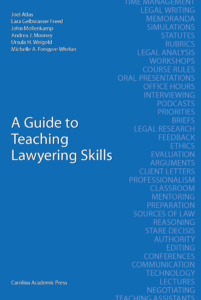This website uses cookies
We use cookies to ensure that we give you the best experience on our website. If you continue to use this site we will assume that you are happy with it.
 There are myriad texts available in law school bookstores about legal writing. But a quartet of Cornell Law professors in the Lawyering Program noticed that the books were leaving one demographic in the cold—legal writing professors.
There are myriad texts available in law school bookstores about legal writing. But a quartet of Cornell Law professors in the Lawyering Program noticed that the books were leaving one demographic in the cold—legal writing professors.
Program director Joel Atlas — along with Lara Gelbwasser Freed, Andrea J. Mooney, Michelle A. Whelan, and two former Cornell Law colleagues, John Mollenkamp and Ursula Weigold—sought to rectify this issue by writing their own book, A Guide to Teaching Lawyering Skills, published by Carolina Academic Press in August.
“A glance at our office bookshelves showed them to be filled with excellent books for students of legal writing but wholly missing any books for professors of legal writing,” says Professor Atlas.
Professors who teach legal writing and research courses are the primary audience for the book. The authors tackle a number of different topics, from simpler issues such as creating a syllabus and setting course goals to looking at the process of grading and providing feedback.
According to Atlas, each professor brought his or her own unique voice to the writing process. “Taking this untraveled path required us to start from scratch and assess the full scope and depth of a legal-writing professor’s responsibilities. In doing so, we shared with each other our own teaching experiences and pedagogical views and, in the process, we all learned from each other.”
Before writing this book, the professors involved had set out with a number of goals that they wanted to achieve. “Our primary goal was to create a how-to guide for teaching the real-life skills employed by practicing attorneys,” says Professor Freed. “We thought that a book that addresses the specific challenges of teaching lawyering skills would be worthwhile, as skills-based teaching does not lend itself to the traditional casebook and Socratic-dialogue method used to teach doctrinal subjects in law school.”
Professor Whelan echoed Freed’s sentiments, adding that the group hoped to create a versatile book for professors that they could use at any time of the day. “Another goal was to create a resource that simultaneously could be, one, a book that serves as an overview of the important aspects of teaching legal writing and, two, a kind of a desk reference that a professor could pick up at any time, go to a particular section in the book, and use as a starting point to answer any particular questions that the professor may have,” says Whelan.
Ultimately, this quartet hopes that their book will be able to impact any professor who owns it. “We are hoping that we created something very practical,” says Professor Mooney. “This will hopefully be the kind of book that professors don’t need to read from start to finish in order to find it useful. Instead they can just turn to the chapter they really need for a particular issue to help them with their teaching.”